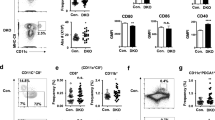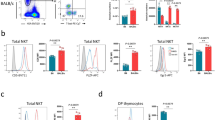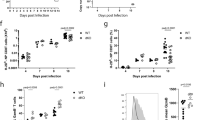Abstract
The costimulatory molecule 4-1BB and its ligand 4-1BBL can control adaptive immunity, but here we show that their interaction also suppressed myelopoiesis. We found that 4-1BBL was expressed on hematopoietic stem cells, differentiating common myeloid progenitors and granulocyte-macrophage progenitors, and 4-1BB was inducible on activated myeloid progenitors. Steady-state numbers of granulocyte-macrophage progenitors, myeloid-lineage cells and mature dendritic cells were higher in 4-1BB- and 4-1BBL-deficient mice, indicative of a negative function, and we confirmed that result with bone marrow chimeras and in vitro, where the absence of interactions between 4-1BB and 4-1BBL led to enhanced differentiation into dendritic cell lineages. The regulatory activity was mediated by 4-1BBL, with binding by 4-1BB inhibiting differentiation of myeloid progenitors. Thus, 4-1BB and 4-1BBL have a previously unknown function in limiting myelopoiesis and the development of dendritic cells.
This is a preview of subscription content, access via your institution
Access options
Subscribe to this journal
Receive 12 print issues and online access
$209.00 per year
only $17.42 per issue
Buy this article
- Purchase on Springer Link
- Instant access to full article PDF
Prices may be subject to local taxes which are calculated during checkout








Similar content being viewed by others
References
Kwon, B.S. & Weissman, S.M. cDNA sequences of two inducible T-cell genes. Proc. Natl. Acad. Sci. USA 86, 1963–1967 (1989).
Goodwin, R.G. et al. Molecular cloning of a ligand for the inducible T cell gene 4-1BB: a member of an emerging family of cytokines with homology to tumor necrosis factor. Eur. J. Immunol. 23, 2631–2641 (1993).
Schwarz, H. Biological activities of reverse signal transduction through CD137 ligand. J. Leukoc. Biol. 77, 281–286 (2005).
Croft, M. Co-stimulatory members of the TNFR family: keys to effective T-cell immunity? Nat. Rev. Immunol. 3, 609–620 (2003).
Watts, T.H. TNF/TNFR family members in costimulation of T cell responses. Annu. Rev. Immunol. 23, 23–68 (2005).
Tan, J.T., Whitmire, J.K., Ahmed, R., Pearson, T.C. & Larsen, C.P. 4-1BB ligand, a member of the TNF family, is important for the generation of antiviral CD8 T cell responses. J. Immunol. 163, 4859–4868 (1999).
Bertram, E.M., Lau, P. & Watts, T.H. Temporal segregation of 4-1BB versus CD28-mediated costimulation: 4-1BB ligand influences T cell numbers late in the primary response and regulates the size of the T cell memory response following influenza infection. J. Immunol. 168, 3777–3785 (2002).
Kwon, B.S. et al. Immune responses in 4-1BB (CD137)-deficient mice. J. Immunol. 168, 5483–5490 (2002).
Lee, S.W., Vella, A.T., Kwon, B.S. & Croft, M. Enhanced CD4 T cell responsiveness in the absence of 4-1BB. J. Immunol. 174, 6803–6808 (2005).
Lee, S.W. et al. Functional dichotomy between OX40 and 4-1BB in modulating effector CD8 T cell responses. J. Immunol. 177, 4464–4472 (2006).
Vinay, D.S., Cha, K. & Kwon, B.S. Dual immunoregulatory pathways of 4-1BB signaling. J. Mol. Med. 84, 726–736 (2006).
Wilcox, R.A., Tamada, K., Strome, S.E. & Chen, L. Signaling through NK cell-associated CD137 promotes both helper function for CD8+ cytolytic T cells and responsiveness to IL-2 but not cytolytic activity. J. Immunol. 169, 4230–4236 (2002).
Huang, Q. et al. The plasticity of dendritic cell responses to pathogens and their components. Science 294, 870–875 (2001).
Wilcox, R.A. et al. Cutting edge: expression of functional CD137 receptor by dendritic cells. J. Immunol. 168, 4262–4267 (2002).
Futagawa, T. et al. Expression and function of 4-1BB and 4-1BB ligand on murine dendritic cells. Int. Immunol. 14, 275–286 (2002).
Lee, S.C. et al. 4-1BB (CD137) is required for rapid clearance of Listeria monocytogenes infection. Infect. Immun. 73, 5144–5151 (2005).
Nishimoto, H. et al. Costimulation of mast cells by 4-1BB, a member of the tumor necrosis factor receptor superfamily, with the high-affinity IgE receptor. Blood 106, 4241–4248 (2005).
DeBenedette, M.A. et al. Analysis of 4-1BB ligand (4-1BBL)-deficient mice and of mice lacking both 4-1BBL and CD28 reveals a role for 4-1BBL in skin allograft rejection and in the cytotoxic T cell response to influenza virus. J. Immunol. 163, 4833–4841 (1999).
Zhu, G. et al. Progressive depletion of peripheral B lymphocytes in 4-1BB (CD137) ligand/I-Eα)-transgenic mice. J. Immunol. 167, 2671–2676 (2001).
Iwasaki, H. & Akashi, K. Myeloid lineage commitment from the hematopoietic stem cell. Immunity 26, 726–740 (2007).
Laiosa, C.V., Stadtfeld, M. & Graf, T. Determinants of lymphoid-myeloid lineage diversification. Annu. Rev. Immunol. 24, 705–738 (2006).
Kondo, M. et al. Biology of hematopoietic stem cells and progenitors: implications for clinical application. Annu. Rev. Immunol. 21, 759–806 (2003).
Akashi, K., Traver, D., Miyamoto, T. & Weissman, I.L. A clonogenic common myeloid progenitor that gives rise to all myeloid lineages. Nature 404, 193–197 (2000).
Kozar, K. et al. Mouse development and cell proliferation in the absence of D-cyclins. Cell 118, 477–491 (2004).
Chen, C.C., Grimbaldeston, M.A., Tsai, M., Weissman, I.L. & Galli, S.J. Identification of mast cell progenitors in adult mice. Proc. Natl. Acad. Sci. USA 102, 11408–11413 (2005).
Shuford, W.W. et al. 4-1BB costimulatory signals preferentially induce CD8+ T cell proliferation and lead to the amplification in vivo of cytotoxic T cell responses. J. Exp. Med. 186, 47–55 (1997).
Saito, K. et al. Infection-induced up-regulation of the costimulatory molecule 4-1BB in osteoblastic cells and its inhibitory effect on M-CSF/RANKL-induced in vitro osteoclastogenesis. J. Biol. Chem. 279, 13555–13563 (2004).
Shin, H.H., Lee, E.A., Kim, S.J., Kwon, B.S. & Choi, H.S. A signal through 4-1BB ligand inhibits receptor for activation of nuclear factor-κB ligand (RANKL)-induced osteoclastogenesis by increasing interferon (IFN)-β production. FEBS Lett. 580, 1601–1606 (2006).
Geissmann, F., Jung, S. & Littman, D.R. Blood monocytes consist of two principal subsets with distinct migratory properties. Immunity 19, 71–82 (2003).
Shortman, K. & Liu, Y.J. Mouse and human dendritic cell subtypes. Nat. Rev. Immunol. 2, 151–161 (2002).
Iwasaki, A. Mucosal dendritic cells. Annu. Rev. Immunol. 25, 381–418 (2007).
Shortman, K. & Naik, S.H. Steady-state and inflammatory dendritic-cell development. Nat. Rev. Immunol. 7, 19–30 (2007).
Naik, S.H. et al. Intrasplenic steady-state dendritic cell precursors that are distinct from monocytes. Nat. Immunol. 7, 663–671 (2006).
van Rijt, L.S. et al. In vivo depletion of lung CD11c+ dendritic cells during allergen challenge abrogates the characteristic features of asthma. J. Exp. Med. 201, 981–991 (2005).
de Heer, H.J. et al. Essential role of lung plasmacytoid dendritic cells in preventing asthmatic reactions to harmless inhaled antigen. J. Exp. Med. 200, 89–98 (2004).
Nikolic, T., de Bruijn, M.F., Lutz, M.B. & Leenen, P.J. Developmental stages of myeloid dendritic cells in mouse bone marrow. Int. Immunol. 15, 515–524 (2003).
Steptoe, R.J., Ritchie, J.M. & Harrison, L.C. Increased generation of dendritic cells from myeloid progenitors in autoimmune-prone nonobese diabetic mice. J. Immunol. 168, 5032–5041 (2002).
Shin, H.H., Lee, J.E. & Choi, H.S. Absence of 4-1BB increases cell influx into the peritoneal cavity in response to LPS stimulation by decreasing macrophage IL-10 levels. FEBS Lett. 581, 4355–4360 (2007).
Schwarz, H., Blanco, F.J., von Kempis, J., Valbracht, J. & Lotz, M. ILA, a member of the human nerve growth factor/tumor necrosis factor receptor family, regulates T-lymphocyte proliferation and survival. Blood 87, 2839–2845 (1996).
Wu, L. & Liu, Y.J. Development of dendritic-cell lineages. Immunity 26, 741–750 (2007).
Fogg, D.K. et al. A clonogenic bone marrow progenitor specific for macrophages and dendritic cells. Science 311, 83–87 (2006).
Varol, C. et al. Monocytes give rise to mucosal, but not splenic, conventional dendritic cells. J. Exp. Med. 204, 171–180 (2007).
D'Amico, A. & Wu, L. The early progenitors of mouse dendritic cells and plasmacytoid predendritic cells are within the bone marrow hemopoietic precursors expressing Flt3. J. Exp. Med. 198, 293–303 (2003).
Landsman, L., Varol, C. & Jung, S. Distinct differentiation potential of blood monocyte subsets in the lung. J. Immunol. 178, 2000–2007 (2007).
Leon, B., Lopez-Bravo, M. & Ardavin, C. Monocyte-derived dendritic cells formed at the infection site control the induction of protective T helper 1 responses against Leishmania. Immunity 26, 519–531 (2007).
Inaba, K. et al. Generation of large numbers of dendritic cells from mouse bone marrow cultures supplemented with granulocyte/macrophage colony-stimulating factor. J. Exp. Med. 176, 1693–1702 (1992).
Wiesmann, A. et al. Expression of CD27 on murine hematopoietic stem and progenitor cells. Immunity 12, 193–199 (2000).
Nolte, M.A. et al. Immune activation modulates hematopoiesis through interactions between CD27 and CD70. Nat. Immunol. 6, 412–418 (2005).
Kabashima, K. et al. Intrinsic lymphotoxin-β receptor requirement for homeostasis of lymphoid tissue dendritic cells. Immunity 22, 439–450 (2005).
Acknowledgements
We thank X. Tang, Y. Adams, Y. Kinjo, W. Xiao, C. Hutter and B. Zhang for technical assistance. Supported by the US National Institutes of Health (AI42944 to M.C.; CA85860 and AI059290 to R.S.M.; AI050265 to H.C.; and EY013325 to B.S.K.), the Arthritis Foundation (B.S.K.), the Diabetes and Immune Disease National Research Institute (S.-W.L.), the Korean Research Foundation (2005-804-E00001 to B.S.K.), the Korean National Cancer Center (0890830-1 to B.S.K.) and the Crohn's and Colitis Foundation of America (Y.P.). This is manuscript 938 from the La Jolla Institute for Allergy and Immunology.
Author information
Authors and Affiliations
Contributions
S.-W.L., Y.P., T.S., R.S.M. and M.C. designed the research and analyzed the data; S.-W.L., Y.P. and T.S. did the experiments at the La Jolla Institute for Allergy and Immunology; S.-W.L. did experiments as a visiting scientist with R.S.M. at Emory University; R.S.M., B.S.K. and H.C. contributed reagents and contributed to the preparation of the manuscript; and S.-W.L. and M.C. wrote the manuscript.
Corresponding author
Supplementary information
Supplementary Text and Figures
Supplementary Figures 1–6 (PDF 651 kb)
Rights and permissions
About this article
Cite this article
Lee, SW., Park, Y., So, T. et al. Identification of regulatory functions for 4-1BB and 4-1BBL in myelopoiesis and the development of dendritic cells. Nat Immunol 9, 917–926 (2008). https://doi.org/10.1038/ni.1632
Received:
Accepted:
Published:
Issue Date:
DOI: https://doi.org/10.1038/ni.1632



